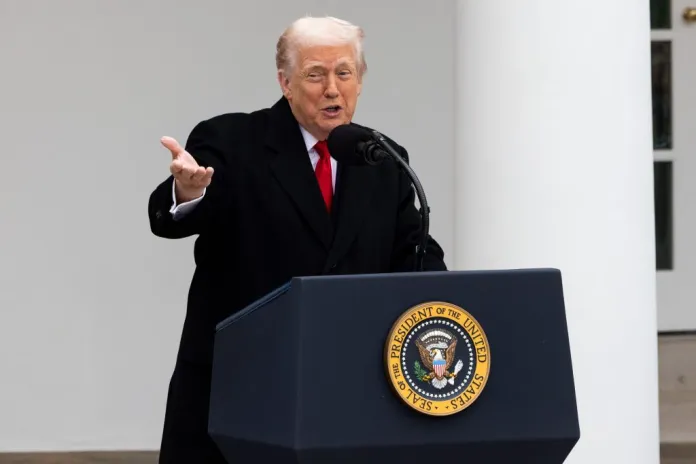Trump’s firing of Bureau of Labor Statistics head is a banana republic move
The article discusses former President Donald Trump’s decision to fire Erika McEntarfer, the head of the Bureau of Labor Statistics (BLS), following a disappointing July jobs report that showed only 73,000 new jobs and downward revisions to previous months. The firing is described as a “banana republic” move, implying political interference in a typically nonpartisan agency. Trump accused the BLS of producing “rigged” job numbers to make Republicans and himself look bad, despite no evidence supporting claims of data manipulation. The article explains the complexity of the BLS’s data collection and revision process, highlighting challenges such as lower survey response rates since COVID-19 and the agency’s need for modernization, which Congress has not funded. It argues that while the BLS data are imperfect and subject to revisions, they remain among the most accurate and obvious economic statistics, essential for government, businesses, and markets.The piece critiques Trump’s firing of McEntarfer as an attempt to deflect from unfavorable economic news, stressing the importance of maintaining the independence and integrity of government statistical agencies free from political pressure.
Trump’s firing of Bureau of Labor Statistics head is a banana republic move
You’ve probably heard the urban legend about the 19th-century naturalist who spent his life traveling the world collecting insect species and then meticulously categorizing them. Long after he gained international fame, the old entomologist was walking the grounds of his estate when he noticed a bug he had never seen before crawling across his path. After staring at the creature momentarily, he brought down his heel and crushed it.
“You don’t exist,” he said and walked away.
This is the story I thought of when President Donald Trump fired Bureau of Labor Statistics Commissioner Erika McEntarfer after the July jobs report featured only 73,000 new jobs and a substantially revised April and June, when job growth slowed, likely due to tariffs and deportations. The firing smacks of banana republic rule, whatever you make of the precision or revisions of the BLS data.
“The president wants his own people there, so that when we see the jobs numbers, they are more transparent and more reliable,” National Economic Council Director Kevin Hassett explained in his ad hoc reasoning.
Trump said the numbers were “RIGGED in order to make the Republicans, and ME, look bad,” not that there was a lack of transparency or need for reform. “Rigged” means manipulated. A White House fact sheet argues that the BLS is “incompetent” and insinuates it’s partisan.
If the jobs report was revised upward, we all know McEntarfer would still have her job. Trump bragged about April employment numbers being “strong” due to “Billions of Dollars” that “pour in from Tariffs,” when we thought the United States outperformed expectations by adding 177,000 jobs. Trump was happy to believe the job numbers.
When data are being “revised all over the place, then there are going to be people that wonder if there is a partisan pattern,” Hassett added.
People are, in fact, now wondering because Trump made the accusation. When data are being revised “all over the place” for both parties, it causes people to think that the process needs reform. When one of the parties fires the person in charge of disseminating data because the number fails to align with the administration’s rosy economic predictions, then the public is going to believe the office has been compromised. And perhaps it will be if the next commissioner’s job is contingent on delivering news that pleases the president.
For instance, Trump has contended that McEntarfer had already “faked the Jobs Numbers before the Election to try and boost Kamala’s chances of Victory.” He used the word “faked,” as in creating something that is counterfeit. However, there is zero evidence that that is true. Indeed, the 818,000-negative revision in August 2024 happened before people voted in the presidential election. At the time, Trump wrote that “Biden’s people FRAUDULENTLY MANIPULATED Job Numbers to hide the disaster they created, 818,000 fewer Jobs!” If that was the case, why didn’t they wait until December? Because the two-month window for revisions never changes, and those revisions likely hurt Democrats in the end, not Trump. The month before Election Day, the economy added a weak 12,000 jobs, which was revised upward by more than 40,000 after Trump won. This all speaks to the nonpartisan nature of the BLS.
Moreover, not one person has explained how the BLS is supposedly cooking the books.
Considering the corrupt behavior of other agencies in recent years, it’s understandable that many Republicans can be so easily convinced that plots against Trump abound. But McEntarfer was confirmed by the Senate 86-8 last year. Then-Sens. JD Vance and Marco Rubio voted for her. She is merely passing on the employment number handed to her by a somewhat flawed system.
The BLS uses two different surveys to measure employment. The first, the establishment survey, relies on nonfarm businesses for the total number of jobs. The second, the household survey, relies on workers for the total unemployment rate.
The monthly jobs report contacts around 120,000 businesses and 630,000 worksites over phone, email, and, yes, even fax. And when businesses respond late, which happens, especially with smaller ones, the numbers are revised over the next couple of months. In a dynamic economy, a workforce of 170 million isn’t easy to track.
The revisions are likely getting bigger because the establishment survey response rate has fallen from 60% to 43% since the outbreak of COVID-19. The BLS has asked for funding to modernize data collection and better track workers’ movements, deaths, new businesses, and growing sectors. The funding was not allocated by Congress. If the BLS were modernized, the numbers would likely be more precise, but the trends would be the same. There will always be revisions. Private sector surveys also have revisions.
Hundreds of people across two departments work on the reports. Many of them would have to circumvent systems to be in on the fix. Otherwise, the BLS commissioner, who is handed the results, would have to blatantly alter the data without anyone noticing. This isn’t an intelligence assessment. These are raw numbers, plugged into existing procedures. The BLS is, unlike most government agencies, relatively transparent on how it does its work.
Trump-friendly economist Steve Moore said the “errors were not random in the Biden years. They always overstated what the number was. … A million misstatements is a big, big problem.” Moore knows well that no one can “overstate” the numbers. But it’s difficult to follow the MAGA reasoning. Trump has complained about “overstated” numbers for former President Joe Biden, and now he’s complaining that the numbers were “overstated” for him.
Yet, for all its faults and statistical limitations, the job reports are one of the most accurate (after revisions) and transparent of any major economy and are still generally respected by the private sector. The BLS numbers aren’t merely a political tool for politicians to convince voters that the economy is doing poorly or well, but a tool for businesses, government (including the Federal Reserve), banks, and investors to make important decisions. The integrity of the BLS matters. Trump has a constitutional right to fire the head of the BLS, which is overseen by the Labor Department. It’s not “authoritarian” to do so, as so many Democrats have contended. What would be best for the public, however, is an agency that operates free of partisan pressure, especially when there’s no evidence to suggest that it operates in a misleading way.
TAXPAYERS NEED GOOD GOVERNMENT DATA
Of course, it’s a lot simpler to tell the average voter that job numbers are “fake” than to explain how tariffs undermine hiring or how deportations, while upholding the law, may have a temporary dulling effect on the numbers — especially among smaller businesses. Trump isn’t the first president to be annoyed by the BLS’s findings. Rather than fire commissioners, former President Barack Obama simply invented a useless metric called “created and saved jobs” to try to fool voters. It is unlikely anyone was really fooled then or now.
But let’s not pretend Trump’s firing of McEntarfer is anything but a transparent effort to deflect bad economic news.
" Conservative News Daily does not always share or support the views and opinions expressed here; they are just those of the writer."




